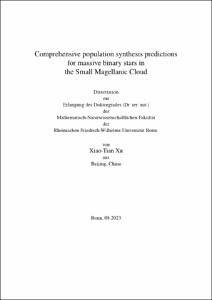Comprehensive population synthesis predictions for massive binary stars in the Small Magellanic Cloud

Comprehensive population synthesis predictions for massive binary stars in the Small Magellanic Cloud

| dc.contributor.advisor | Langer, Norbert | |
| dc.contributor.author | Xu, Xiao-Tian | |
| dc.date.accessioned | 2024-01-30T14:52:07Z | |
| dc.date.available | 2024-01-30T14:52:07Z | |
| dc.date.issued | 30.01.2024 | |
| dc.identifier.uri | https://hdl.handle.net/20.500.11811/11282 | |
| dc.description.abstract | The past and ongoing gravitational wave detections have fostered a wide interest in understanding the formation of binary black holes (BBHs). Several formation scenarios have been proposed, including the evolution of isolated massive binaries. While most of the observed merging black holes are at cosmological distances, and thus likely at low metallicity, the Small Magellanic Cloud (SMC) — one of the satellite galaxies of the Milky Way — provides a unique laboratory to probe the binary scenario thanks to its rich massive star population and low metallicity. In this thesis, we provide comprehensive synthetic SMC populations of massive binary stars throughout all their different evolutionary stages, based on a dense grid of more than 50,000 detailed binary evolution models. As stars expand when they age, mass transfer occurs in most of our models. This leads to a spin-up of the mass gainers to produce rapidly rotating so called Be/Oe emission line stars, which are abundant in the SMC. The mass donors, if massive enough, may form so called Wolf-Rayet (WR) stars, which are hydrogen deficient and have emission line dominated spectra. Our models predict 7 so called WR + main sequence star (MS) binaries in the SMC, which roughly matches the observed number, even though our models produce more long-period WR binaries than observed. At the same time, our synthetic population contains ~ 200 BH+MS binaries, mostly associated with Be/Oe stars, which are so far undetected. We show that this is not in contradiction to the small number of wind-accreting BH+MS binaries observed through their X-ray emission. We also predict a neutron star (NS) +MS population, for which our models reproduce the orbital period distribution of the observed rich Be/X-ray binary population, but not their number. On the other hand, we predict a so far undiscovered group of X-ray quiet NS binaries with orbital periods below 10 days. We then use semi-analytic methods to investigate which of our BH+MS binaries can evolve into a BH+WR system, which of those evolve further into a BBH, and which of those can merge within the Hubble time. Our results predict a high BH companion fraction for WR stars, and 2-3 BH+WR binaries in the SMC. Our prediction on merging BBHs is sensitive to several model assumptions. The main features of the observed merging BBH population can be reproduced by our model, with common envelope evolution and stable mass transfer evolution contributing about equally. In conclusion, while our model in part agrees with the observed populations, it also raises new questions. In particular, there is an apparent lack of long-period massive evolved binaries with WR or BH components. As those are harder to detect than the shorter period counterparts, we hope that future observing campaigns will have the power to resolve this issue. | en |
| dc.language.iso | eng | |
| dc.rights | In Copyright | |
| dc.rights.uri | http://rightsstatements.org/vocab/InC/1.0/ | |
| dc.subject.ddc | 520 Astronomie, Kartografie | |
| dc.title | Comprehensive population synthesis predictions for massive binary stars in the Small Magellanic Cloud | |
| dc.type | Dissertation oder Habilitation | |
| dc.publisher.name | Universitäts- und Landesbibliothek Bonn | |
| dc.publisher.location | Bonn | |
| dc.rights.accessRights | openAccess | |
| dc.identifier.urn | https://nbn-resolving.org/urn:nbn:de:hbz:5-74337 | |
| dc.relation.doi | https://doi.org/10.1051/0004-6361/202141214 | |
| ulbbn.pubtype | Erstveröffentlichung | |
| ulbbnediss.affiliation.name | Rheinische Friedrich-Wilhelms-Universität Bonn | |
| ulbbnediss.affiliation.location | Bonn | |
| ulbbnediss.thesis.level | Dissertation | |
| ulbbnediss.dissID | 7433 | |
| ulbbnediss.date.accepted | 18.01.2024 | |
| ulbbnediss.institute | Mathematisch-Naturwissenschaftliche Fakultät : Fachgruppe Physik/Astronomie / Argelander-Institut für Astronomie (AIfA) | |
| ulbbnediss.fakultaet | Mathematisch-Naturwissenschaftliche Fakultät | |
| dc.contributor.coReferee | Bertoldi, Frank |
Dateien zu dieser Ressource
Das Dokument erscheint in:
-
E-Dissertationen (4337)




